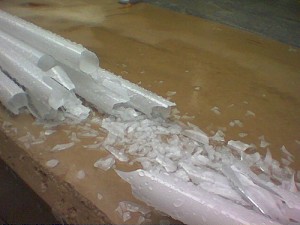This afternoon I was removing a dead CFL from a fixture in the kitchen when it broke in my hand, sending mercury-tainted glass towards my face and the floor. Our kitchen had been remodeled by the previous owner before he put the house up for sale, and he brought up to compliance with California Title 24 requirements for lighting, which at the time could only have been met with CFL fixtures that used bulb bases incompatible with the ubiquitous “edison base” used by incandescent bulbs — after all, with regular bases, what would stop someone from replacing the CFLs with awful incandescents?
I’ve never liked the setup, and part of the reason is the many compromises that come with CFLs. Though they have certainly saved energy, they’ve been a failure on several other levels. First, they are expensive, between $8-14 in my experience. (These are G24 based bulbs, not the cheap edison-compatible retrofits) Furthermore, they fail. A lot. We’ve lived in this house since 2012 and our kitchen has six overhead cans. I’ve probably replaced 7 or 8 bulbs in that time. Finally, with the fancy CFL-only bases come electro nic ballasts, built into the fixture. One has failed already and it can only be replaced from the attic. I hate going up there, so I haven’t done it even though it happened six months ago. The ballasts also stop me from putting in LED retrofits. I’ll have to remove them all first.
nic ballasts, built into the fixture. One has failed already and it can only be replaced from the attic. I hate going up there, so I haven’t done it even though it happened six months ago. The ballasts also stop me from putting in LED retrofits. I’ll have to remove them all first.
The thing is, only a few years ago, it seemed like every environmentalist and energy efficiency expert was telling us (often in pleading, patronizing tones) to switch to CFLs. They cost a bit more, but based on energy savings and longer life, they’d be cheaper in the long run. But it turns out that just wasn’t true. It was theoretically true but practically not. Unfortunately, this is not uncommon in the efficiency world.
There were other drawbacks to CFLs. They did not fit lamps that many people had. The color of their light was irksome. There was flicker that some people could detect. When they broke, they released mercury into your home, that, if it fell into carpet or crevices in the floor, would be their essentially forever. Most could not dim, and those that could have laughably limited dimming range.Finally, they promised longevity, but largely failed to deliver.
Basically, for some reason, experts could not see what became plainly obvious to Joe Homeowner: CFLs kinda suck.
So, was pushing them a good idea, perhaps based on what was known at the time?
I would argue no. This was a case of promoting a product that solved a commons problem (environmental impact of energy waste) with something whose private experience was worse in almost every way possible. Even the economics, touted as a benefit, failed to materialize in most cases.
I would argue that the rejection (and even political backlash) against CFLs was entirely predictable, because 1) over promising benefits 2) downplaying drawbacks and 3) adding regulation does not make people happy. What does make people happy is a better product.
So far, it looks like LEDs are the better product we need. They actually are better than incandescent bulbs in most ways, and their cost is coming down. I’m sure their quality will come down, too, as manufacturers explore the price/performance/reliability frontier, and we may end up throwing away more LED fixtures than any environmentalist could imagine. Not so far; things are holding. They’re a lighting efficiency success, perhaps the first since incandescent bulbs replaced gas and lamp oil.
The lesson for energy efficiency advocates, I think, is:
- UNDERpromise and OVERdeliver
- do not try to convince people that an inferior experience is superior. Sure, some will drink the Kool-Aid, but most won’t. Consider what you’re asking of people.
- Do not push a technology before its time
- Do not push a technology after its time (who’s days are numbered)
I agree with you *almost* 100%. But a) I often blame the cat for things that break, and b) it depends on your reference standard. In Japan we had fluorescent tubes (the circular kind) with ballast that threw unpleasant, flickery light, but that is what there was, everywhere. CFLs are better than that. And they now fit standard Edison sockets and are pretty light-bulb-like. Still, they were oversold and are hard to recycle (even here). I’m still waiting for my reasonably priced LEDs, but they do seem to be on the way, and soon.
I guess my point was mostly just that the results of the campaign to push CFLs was predictable. It was a ‘bitter medicine’ campaign, rather than a ‘candy’ campaign.
There are time when you just have to pursue a medicine campaign, but considering what a blip CFLs were on the technological timeline, it seems like this was not one of those times.
Or maybe I’m wrong. CFLs are still improving, too. I think LEDs will eclipse them, but maybe not. In fact, I just saw something the other day that suggested major efficiency leaps were possible for incandescent bulbs, too.
It’s actually an exciting time for lighting, I mean, to the degree that lighting can be exciting.
Also, I should clarify: the reason the CFLs in our kitchen do not have Edison bases was not technology, was the law. CA Title 24 forbid Edison-base fixtures in certain locations because it would be too easy for a homeowner to screw in an incandescent. As it turns out, it would have been easy to screw in an LED, too, but…..